User:JMvanDijk/Sandbox 12/Box12
From Cornish heraldry
The phrase Tre, Pol and Pen is used to describe people from or places in Cornwall, UK. The full rhyming couplet runs: By Tre Pol and Pen / Shall ye know all Cornishmen,[1][2] a version of which was recorded by Richard Carew in his Survey of Cornwall, published in 1602.[3] Many Cornish surnames and place names still retain these words as prefixes, such as the surname Trelawny and the village Polzeath. Tre in the Cornish language means a settlement or homestead; Pol, a pond, lake or well; and Pen (also Welsh and Cumbric), a hill or headland. Cornish surnames and placenames are generally pronounced with the emphasis on the second syllable.[4]
List of Cornish Arms[edit]
 |
 |
 |
|---|---|---|
Arms of Richard of Cornwall, Earl of Cornwall: Argent, a lion rampant gules crowned or a bordure sable bezantée.
|
Arms of Richard, 1st Earl of Cornwall as King of the Romans
|
Richard, 1st Earl of Cornwall as King of the Romans
|
Duke of Cornwall[edit]
For further reading; Coat of arms of the Prince of Wales
| Title | Escutcheon | Greater Version |
Blazon | Date of Creation |
|---|---|---|---|---|
| Duke of Cornwall | 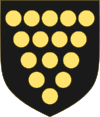
|
 |
Sables, Fifteen bezants or, five, four, three, two, one | 1337 |
| Duke of Cornwall (as the Prince of Wales) |

|
 |
Quarterly, 1st and 4th Gules three lions passant guardant in pale Or armed and langued Azure (for England), 2nd quarter Or a lion rampant within a double tressure flory-counter-flory Gules (for Scotland), 3rd quarter Azure a harp Or stringed Argent (for Ireland), with over all a label of three points Argent, and on an inescutcheon ensigned by the coronet of the heir-apparent, quarterly, Or and Gules four lions passant guardant counterchanged (for the Principality of Wales) | 1911 |
| Shield of Peace |  |
Sables, three feathers argent, slipped through scrolls inscribed 'Ich Dien' | 1337 |
A[edit]
| Name | Escutcheon | Blazon | Seat or Residence |
|---|---|---|---|
| Arundell | 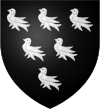
|
Sable, six martlets argent | • Trerice |
B[edit]
| Name | Escutcheon | Blazon | Seat or Residence |
|---|---|---|---|
| Basset | 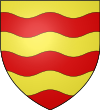
|
Barry wavy of six or and gules | • Tehidy |
| Boscawen | 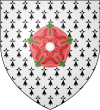
|
Ermine, a rose gules barbed and seeded proper | • Falmouth |
| Buller | 
|
Sable, on a cross argent quarter pierced of the field four eagles displayed of the first | • Trenant Park [5] |
C[edit]
| Name | Escutcheon | Blazon | Seat or Residence |
|---|---|---|---|
| Cornewall baronets | 
|
Arms of Cornewall: Argent, a lion rampant gules ducally crowned or a bordure engrailed sable bezantée (being the arms of Richard, 1st Earl of Cornwall (1209-1272) with difference a bordure engrailed[6])
[7]
[8] Cite error: A |
Moccas Court, co. of Hereford |
| Coryton | 
|
Argent, a saltire sable | • Pentillie [10] |
| Curnow | 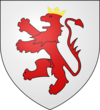
|
Argent, lion rampant gules with a ducal crown or | |
| Cutts | 
|
Argent, a bend engrailed sables, three roundels argent. | • Calstock |
E[edit]
| Name | Escutcheon | Blazon | Seat or Residence |
|---|---|---|---|
| Edgcumbe | 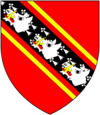
|
Gules, bend ermines cotised or three boar's heads couped argent | • Cotehele • Mount Edgcumbe, Maker |
| Elliot | 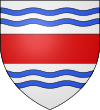
|
Argent, a Fess Gules, between double-cotises wavy Azure | • Port Eliot |
F[edit]
| Name | Escutcheon | Blazon | Seat or Residence |
|---|---|---|---|
| Fortescue | 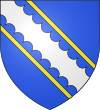
|
Azure, a bend engrailed argent plain cotised or | • Boconnoc |
| Fox | 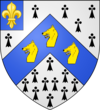
|
Ermine, chevron azure, three foxes or, canton azure, fleur de lis or | • Falmouth |
| Friend | 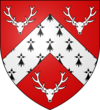
|
Gules, chevron ermine, three deer argent | • Calstock |
G[edit]
| Name | Escutcheon | Blazon | Seat or Residence |
|---|---|---|---|
| Godolphin | 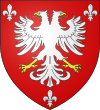
|
Gules, an eagle with two heads, displayed between three fleurs-de-lys, two and one, argent | • Godolphin House |
| Goss | 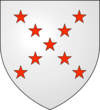
|
Argent, mullet gules, two, two, one, two, two | • Goss's boatyard, Calstock |
| Grenville | 
|
Gules, three clarions or |
K[edit]
| Name | Escutcheon | Blazon | Seat or Residence |
|---|---|---|---|
| Killigrew | 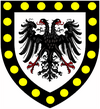
|
Argent, bordure sables, 15 bezants or, eagle sables |
M[edit]
| Name | Escutcheon | Blazon | Seat or Residence |
|---|---|---|---|
| Molesworth-St Aubyn | 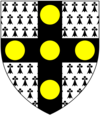
|
Ermine, on a cross sable five bezants [11] | • Pencarrow |
P[edit]
| Name | Escutcheon | Blazon | Seat or Residence |
|---|---|---|---|
| Pascoe | 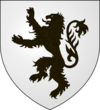
|
Argent, lion rampant sable | |
| Pengelly | 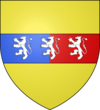
|
||
| Prideaux | 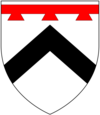
|
Argent, a chevron sable in chief a label of three points gules [12] | • Prideaux Place |
R[edit]
| Name | Escutcheon | Blazon | Seat or Residence |
|---|---|---|---|
| Rashleigh | 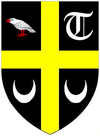
|
[Text missing]Argent beaked and legged gules; in the second quarter: a text "T"; in the third and fourth quarters: a crescent all of the third | • Menabilly • Fowey |
| Robartes | 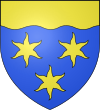
|
Azure, three estoiles and a chief wavy or | • Lanhydrock |
S[edit]
| Name | Escutcheon | Blazon | Seat or Residence |
|---|---|---|---|
| Scoble | 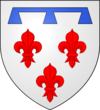
|
Argent, lapel azure and three Fleur-de-lis gules | • Calstock |
| Southcott | 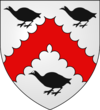
|
Argent, chevron engrailed gules, three coots sable | • Calstock • Callington |
| St Aubyns | 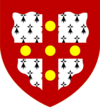
|
Ermine on a Cross Gules five Bezants all within a Bordure wavy of the second | • St Michael's Mount |
T[edit]
| Name | Escutcheon | Blazon | Seat or Residence |
|---|---|---|---|
| Thomas | 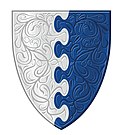 |
Per pale nebuly argent and azure,[13] as borne by Thomas of Lelant, Thomas of Crowan, Thomas of Tremayne, Thoms, and Bosarvane, also Thomas, of St Just | • St Just in Penwith |
| Treffry | 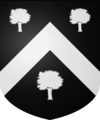
|
Sable, a Chevron between three Trees Argent.[14] | • Place, Fowey |
| Trelawny | 
|
Argent, chevron sable [15] | • Harewood House, Calstock • Trelawny, Pelynt |
| Trevelyan | 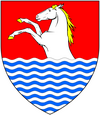
|
Gules, a demi-horse argent hoofed and maned or issuing out of water in base proper [16] | • St Veep |
W[edit]
| Name | Escutcheon | Blazon | Seat or Residence |
|---|---|---|---|
| Westlake | 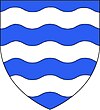
|
Azure, wavy argent | • Calstock • Gunnislake • Tavistock |
| Wilcox | 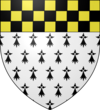
|
Ermine, chief chequy or and sable | • Kelly House, Calstock |
| Williams | 
|
Vair, three crescents or | • Harewood House, Calstock • St Michael Caerhays • Scorrier House; Burncoose |
| Worth | 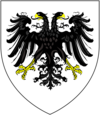
|
Argent, eagle sable | • Calstock |
Cornish Symbolism[edit]

There are several charges and tinctures (colourings) used frequently in Cornish heraldry. These are derived mainly from Cornish royal and national symbolism.
Common charges[edit]
- Chough: the Cornish Chough, Cornwall's national bird, is very widely used in Cornish heraldry.

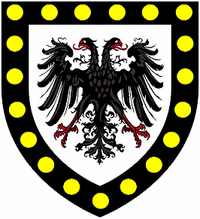
- Double-headed eagle: eagles with two heads occur prominently in several Cornish arms, in contrast to the rest of Britain where they are rare. The popularity of this form of eagle is probably due to Richard, Earl of Cornwall, who bore such an eagle in his role as King of the Romans.[17]
- Bezants: Lower describes how Cornish families took the bezant from the arms of the ancient earls of Cornwall, "this coat is pretended to from Cadock or Cradock earl of Cornwall in the fifth century". The bezant in fact derives from the arms of Richard, Earl of Cornwall.
- Rose: the rose is an extremely common charge in Cornish heraldry, thought by Lower to originate in the Wars of the Roses. William Smith Ellis thought it might have been derived from an unknown Anglo-Norman family in Cornwall using it as an emblem and passing it on to their supporters. It is more likely, however, to derive from the Cornish placename element ros meaning a promontory or heathland, or res, a ford, Cornish gentry often using the name of their major estate as a surname. It is used by the family of Boscawen originally from Boscawen Rose.[17][18]
Mottoes[edit]
Many Cornish families from ancient times bore mottoes in the Cornish language, many of which were recorded in the 17th century. The practice of using Cornish language mottoes continues to this day. Examples include:
Familial examples[edit]
- Vaughan - Asgre lan dyogel ey pherchen (A good conscience is the best shield)
- Carminow - Cala rag whethlow (A straw for the talebearer)
- Glynn - Dre weres agan Dew ny (By the help of our God)
- Truscott and Gay - Gwir yn erbyn y byd (the truth against the world)
- Polwhele - Karenza wheelas Karenza (Love seeks out love)
- Tonkin - Kensol tra Tonkyn, ouna Dew mathern yn (Before all things Tonkin, fear God in the King)
- Williams - Meor vas tha dew (Gracious is thy God)
- Polkinghorne - Rag Matern a pow (For King and Country)
- Bolitho - Re deu (By God)
- Ruddle - Ruthek ha yagh (Ruddy and hearty)
- Tremenheere - Thrugscryssough ne Deu a nef (Do not disbelieve in God of Heaven)
- Tonkin - Yn ton kyn nyjyaf (In a wave I swim)
- Godolphin - Frank ha leal ettoga (Free and Loyal Forever) and Franc ha leal atho ve (Free and Loyal Am I)
- Boscawen -Bosco, Pasco, Karenza Venza (canting arms of unknown meaning, however Karensa a vynsa, covaytys ny vynsa (Love would, greed wouldn't) is a Cornish saying)
- Harris of Keneggy - Car Deu reyz pub tra (Love God above all)
- Noye of St Buryan - Teg yw hedhwch (Fair is peace)
- Gwavas - En Hav perkou Gwav (In summer remember winter)
- Sloggett of Tresloggett - Bethoh Dur (Be Bold)
- Harvey - Arva hep arveth (To arm without aggression)
- Tangye - Tangy an dorgallow
- Trenear-Harvey - "Harth mes Len" (Boldly but sincerely)
Corporate examples[edit]
- Cornish Guild of Heralds - Tyr ha Tylu (Land and Family)
- Cornwall Council - Onen hag Oll (One and All)
- Old Cornwall societies - Myghtern Arthur nyns yu marrow (King Arthur is not dead)
- Federation of Old Cornwall Societies - Kyntelleugh an brewyon es gesys na vo kellys travyth (Gather ye the fragments that are left, that nothing be lost)
- Gorseth Kernow - An gwyr erbyn an bys (The truth against the world)[19][20]
References[edit]
- ^ Tre, Pol and Pen - The Cornish Family by Bernard Deacon
- ^ Cornish surnames - By Tre, Pol and Pen shall ye know all Cornishmen
- ^ Richard Carew, The Survey of Cornwall (Page 48)
- ^ Words & Phrases, West Penwith
- ^ Burke's Landed Gentry, 1937, p.279, Buller of Downes
- ^ Courthope, William, ed. (1835). Debrett's Baronetage of England (7th ed.). London: J.G. & F. Rivington. p. 185.
- ^ assumed by royal licence in 1771,"No. 11162". The London Gazette. 16 July 1771. p. 1.
"His Majesty has been pleased to grant to Sir George Amyand, Bart., his full power, licence and authority to assume and use the surname of Cornewall and also to bear the arms of Cornewall" together with surname of Cornewall, by Sir George Cornewall, 2nd Baronet (1748–1819)
- ^ "No. 10442". The London Gazette. 7 August 1764. p. 1.
- ^ Richardson, Douglas (2011). Everingham, Kimball G (ed.). Plantagenet Ancestry: A Study in Colonial & Medieval Families (2nd ed.). Salt Lake City: CreateSpace. ISBN 9781461045137. Vol. I pp. 574-5; Vol II p 265.
- ^ Pentillie Castle described in Devonshire & Cornwall illustrated, from original drawings by T. Allom (1832) p.16-17, on Google Books.
- ^ Debrett's Peerage, 1968, p. 709
- ^ Vivian (1895), p. 616
- ^ "The Visitations of Cornwall". ukga.org. Retrieved 2019-08-21.
- ^ Herald's Visitations of Cornwall 1620
- ^ Kidd, Charles, Debrett's peerage & Baronetage 2015 Edition, London, 2015, p.B796
- ^ Debrett's Peerage, 1968, p.798
- ^ a b Lower, Mark Antony (1845). The Curiosities of Heraldry. London: John Russell Smith.
- ^ William Smith Ellis, A Plea for the Antiquity of Heraldry: with an attempt to expound its theory and elucidate its history, 1853 - Cornish heraldry
- ^ W. H. Pascoe, A Cornish Armory, 1979
- ^ D. Endean Ivall, Cornish Heraldry and Symbolism, 1988
